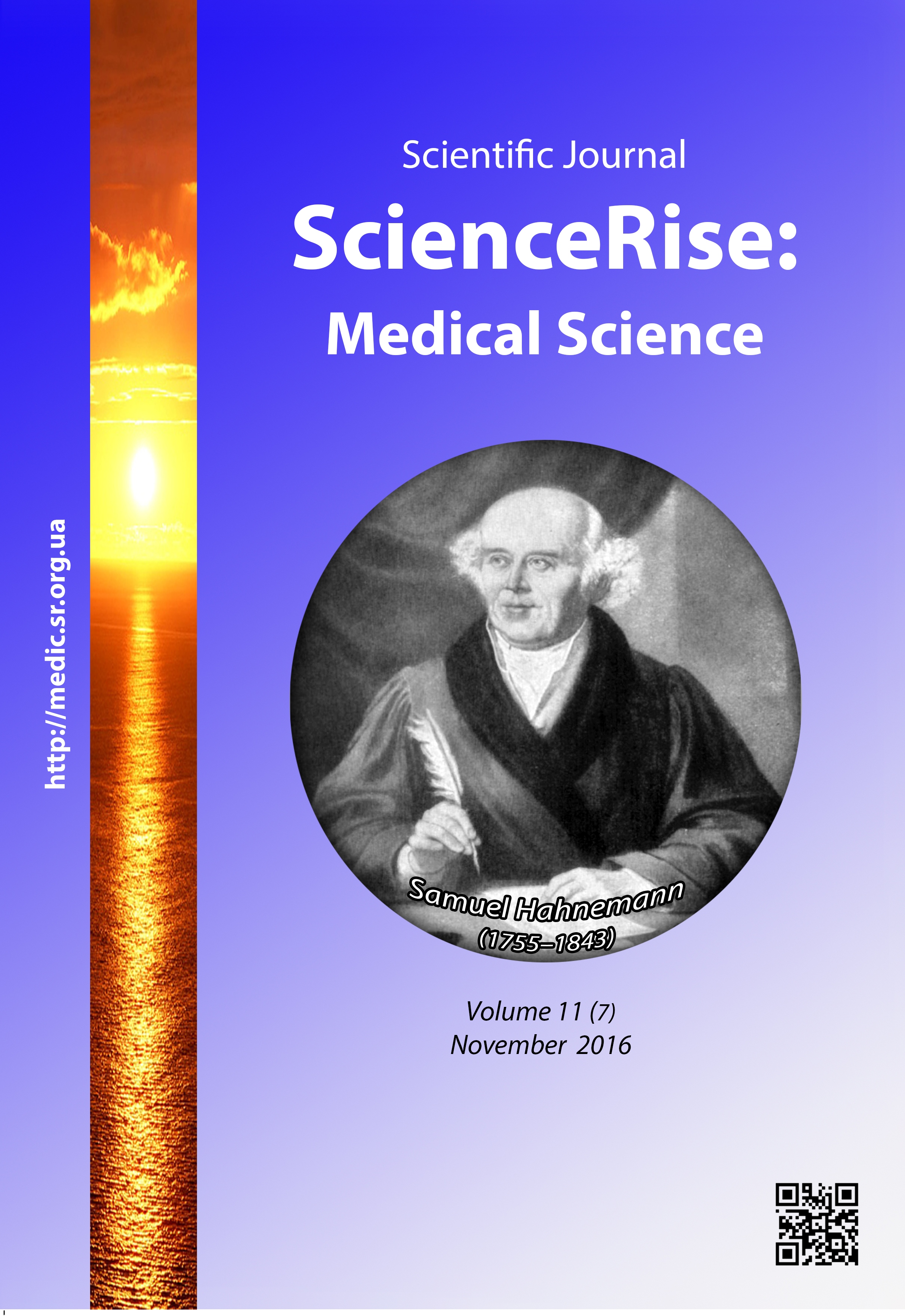The research of social and clinico-dynamic factors of predisposition to development of depressive symptoms in patients with paranoid schizophrenia
DOI:
https://doi.org/10.15587/2519-4798.2016.84932Keywords:
depression, schizophrenia, predisposition, social functioning, risk, mutual influence, dynamics, inclination, treatmentAbstract
Background. The raise of the quality of diagnostics of depressive symptomatology in patients with paranoid schizophrenia by revelation of the factors of predisposition to its development.
Materials and methods. 82 хворих patients (studied group) were examined for paranoid schizophrenia with depressive syndrome and 47 – without the syndrome of depression (group of comparison). For this aim the clinical-anamnestic, socio-demographic, clinico-psychopathological and pathopsychological methods of research were used. The scales PANSS, CDSS, HARS, HDRS, questionnaire for the assessment of social functioning and the life quality of psychic patients were also used. On the base of received results the prognostic importance of the separate factors of predisposition to the development of depressive symptomatology in patients with paranoid schizophrenia was assessed.
Results of research. Social predisposing factors: absence of own family; inability to use the existent educational and professional potential; absence of work and short employment history. The age and gender belonging had not essential influence on the development of depressive symptomatology. The clinico-dynamic factors of predisposition were determined as: depressive-paranoid syndrome in the period of exacerbation; duration of exacerbation period more than 40 days; development of depressive symptomatology at the beginning of disease and its further conservation; raise of the frequency of rehospitalizations with the course of disease; short dose of supporting therapy and short-term remissions without rehabilitation support; continuous-progredient course of disease with development of apathetic-abulic defect.
Conclusions. Depressive symptomatology can develop at any stage of schizophrenia disease. Being associated with depressive symptomatology, disease fast acquires the unfavorable, malignant course with reduction of the quality and duration of emissions and raise of rehospitalization level already in first 5 years of disease. It is proved by the low level of compliance, development of hospitalism, decrease of social functioning and level of life quality. The revealed social and clinico-dynamic predisposition factors will allow raise the level of diagnostics of depressive symptomatology in patients with paranoid schizophrenia. Elaboration of the complex socio-medical rehabilitation of patients with depressive symptomatology at paranoid schizophrenia that takes into account the revealed factors of predisposition will favor the increase of the level of social functioning and life quality of this contingent of patientsReferences
- Orlova, N. M., Khaustova, O. O., Chaban, O. S. (2011). Diahnostyka, strukturno-nozolohichnyi analiz ta korektsiia anhedonii pry shyzofrenii [Diagnosis, structural analysis and correction nosological anhedonia in schizophrenia]. Kyiv: Naukovyi svit, 18.
- Montross, L. P., Kasckow, J., Golshan, S., Solorzano, E., Lehman, D., Zisook, S. (2008). Suicidal Ideation and Suicide Attempts Among Middle-Aged and Older Patients With Schizophrenia Spectrum Disorders and Concurrent Subsyndromal Depression. The Journal of Nervous and Mental Disease, 196 (12), 884–890. doi: 10.1097/nmd.0b013e31818ec823
- Vasile, D., Vasiliu, O., Vasile, M. (2010). Suicide Risk Factors Assessment in Schizophrenia. Proceedings of the International Conference on risk management, assessment and mitigation, 481–484.
- Naprjejenko, O. K., Procyk, V. O., Pampuha, L. S. (2006). Shyzofrenija z symptomamy depresii': klinichni projavy ta likuvannja tiorylom (tiorydazynom) [Schizophrenia symptoms of depression: clinical manifestations and treatment by “Tioryl” (thioridazine)]. Ukrainian Journal of Psychoneurology, 14/1 (46), 90–92.
- Pinchuk, I. Ja., Bogachev, R. M., Hobzej, M. K., Petrychenko, O. O. (2013). Dynamika psyhichnogo zdorov’ja naselennja Ukrai'ny v period 2008–2012 rr. ta perspektyvy rozvytku psyhiatrychnoi' dopomogy krai'ny [The dynamics of mental health Ukraine in the period 2008–2012 years and the prospects for the development of mental health care country]. Archives of Psychiatry, 19 (1), 11–17.
- Rjapolova, T. L. (2008). Obosnovanie rannej reabilitacii bol'nyh shizofreniej [Rationale for early rehabilitation of patients with schizophrenia]. Journal of Psychiatry and Medical Psychology, 1 (18), 16–21.
- Felmet, K., Zisook, S., Kasckow, J. (2011). Elderly Patients with Schizophrenia and Depression: Diagnosis and Treatment. Clinical Schizophrenia & Related Psychoses, 4 (4), 239–250. doi: 10.3371/csrp.4.4.4
- Tiganov, A. S. (2011). Jendogennye affektivnye rasstrojstva: problemy sistematiki i tipologii [Endogenous affective disorders: problems of taxonomy and typology]. Herald of the Russian Academy of Medical Sciences, 4, 4–10.
- Jur'eva, L. N., Shevchenko, Ju. N. (2012). Profilaktika suicidal'nogo povedenija u pacientov s depressivnymi rasstrojstvami v kontekste dokazatel'noj mediciny [Prevention of suicidal behavior in patients with depressive disorders in the context of evidence-based medicine]. Ukrainian Journal of Neuropsychiatry, 20/3 (2), 238–239.
- Goncharov, V. E. (2010). Osobennosti klinicheskoj kartiny shizofrenicheskih psihozov na sovremennom jetape [Features of clinical picture of schizophrenic psychosis at the present stage]. The Tauride Journal of Psychiatry, 14/1 (50), 18–22.
Downloads
Published
How to Cite
Issue
Section
License
Copyright (c) 2016 Христина Сергіївна Живаго

This work is licensed under a Creative Commons Attribution 4.0 International License.
Our journal abides by the Creative Commons CC BY copyright rights and permissions for open access journals.
Authors, who are published in this journal, agree to the following conditions:
1. The authors reserve the right to authorship of the work and pass the first publication right of this work to the journal under the terms of a Creative Commons CC BY, which allows others to freely distribute the published research with the obligatory reference to the authors of the original work and the first publication of the work in this journal.
2. The authors have the right to conclude separate supplement agreements that relate to non-exclusive work distribution in the form in which it has been published by the journal (for example, to upload the work to the online storage of the journal or publish it as part of a monograph), provided that the reference to the first publication of the work in this journal is included.









